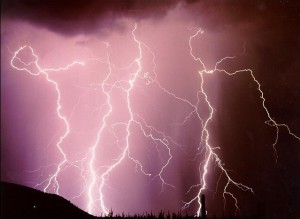14 December 2010
It’s Raining Electrons!
Posted by mohi
We all know that it can rain a great many odd things: cats and dogs, men, and even, in one particularly bizarre instance in Argentina in 2007, spiders.
But before attending session AE13B: Thunderstorm Effects in the Near-Earth Space Environment I, I had never heard of raining electrons.
I guess I could be excused for missing them. Electron precipitation occurs in the ionosphere, hundreds of kilometers above the surface of the Earth. Highly energetic electrons, which are blown towards Earth on the solar wind, are normally trapped by the planet’s protective magnetic field. The ensnared electrons might spiral around magnetic field lines for years, but electromagnetic waves propagating through the outer atmosphere offer the chance of a jailbreak. The waves push the electrons out of their trapped state and towards the ionosphere, in a kind of electron shower.

Lightning strikes, such as this one near Tucson, Ariz., can generate electron showers in the upper atmosphere. Photo courtesy of NOAA
Lightning strikes on Earth can cause these showers by producing electromagnetic waves that travel all the way to the outer atmosphere. The raining electrons change the properties of the Earth’s atmosphere–as they fall they collide with oxygen or nitrogen molecules. The high-energy run-ins cause interference with communication transmissions. We all know how important reliable, high-speed communication is in this era of globalization, so it is not hard to grasp why scientists want to better understand how lightning strikes induce electron precipitation.
It’s possible to actually “see” electron precipitation, because electron-air molecule collisions also release photons. The visual signature of electron rain from lightning is similar to the aurora, but much, much dimmer. And Robert Marshall, from the Center for Space Physics at Boston University, might now have an answer for the question of just how much dimmer.
In a talk entitled Signatures of Lightning-induced Electron Precipitation, Marshall presented a new model of optical emissions from lightning-induced electron precipitation. The brightness of the emissions depends on the how much electrical current a lightning strike produces and also on the geographical location of the strike. But still, the optical signature of lightning-induced electron rain is on average about 30,000 times dimmer than auroras.
This might not sound that bright, but photometers exist that can detect such small increments of light intensity. And while I might not be noticing the electron weather any time soon, for scientists seeking to better characterize how electron precipitation affects radio communication, that tiny change in brightness might be as noteworthy as precipitating spiders.
–Catherine Meyers is a science communication graduate student at UC Santa Cruz










 GeoSpace is a blog on Earth and space science, managed by AGU’s Public Information staff. The blog features posts by AGU writers and guest contributors on all sorts of relevant science topics, but with a focus on new research and geo and space sciences-related stories that are currently in the news.
GeoSpace is a blog on Earth and space science, managed by AGU’s Public Information staff. The blog features posts by AGU writers and guest contributors on all sorts of relevant science topics, but with a focus on new research and geo and space sciences-related stories that are currently in the news.